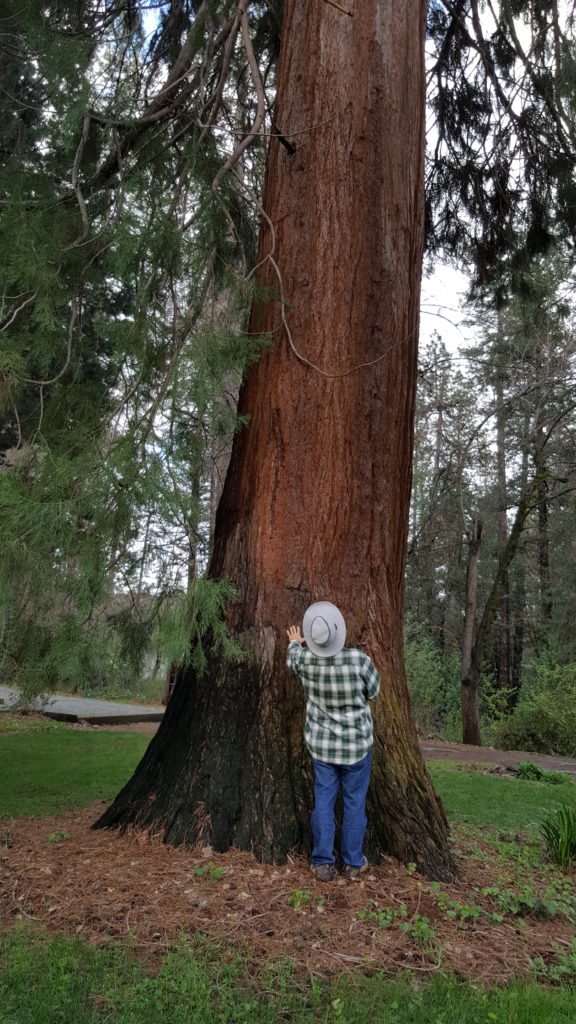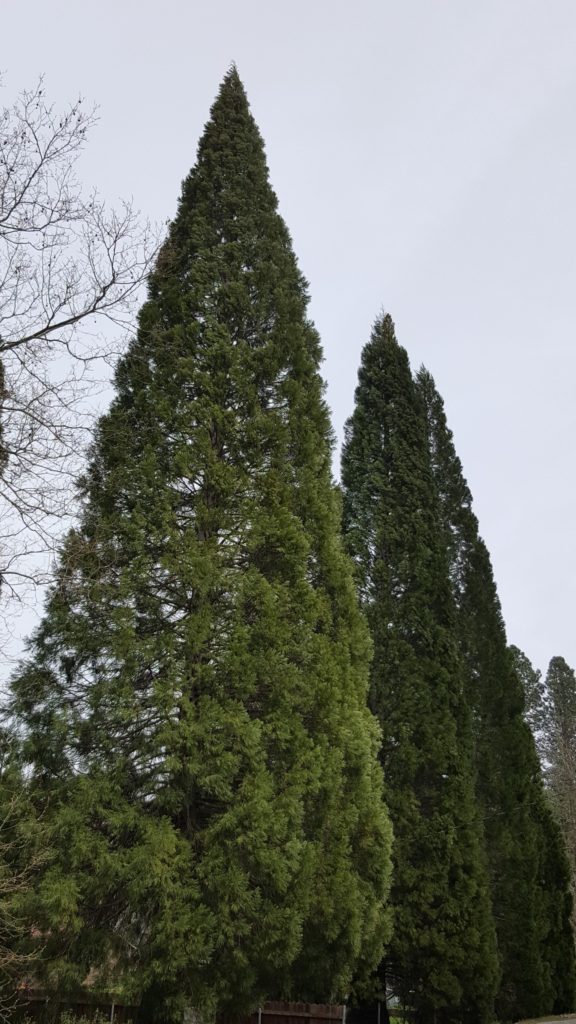Once when I was backcountry skiing in King’s Canyon National Park I was on a constant lookout for the big trees, the Giant Sequoias (Sequoiadendron giganteum). I had seen them a few years prior in their protected groves, fenced off from damaging human footsteps, with nicely paved winding trails from which to view them. They were big and beautiful and I was immediately in love with them; yet somehow my mind couldn’t really quite absorb their massiveness.
So I was looking forward to seeing them again, away from cars, people, and paths. There were lots of very large Jeffrey Pines and Incense Cedars and I expected the big trees to be just somewhat larger. When I finally spotted the first one I was awe-struck. It was far above and beyond the biggest of the rest of the trees in the forest. The trunk was massive with glowing golden red bark in vertical striations that shone out through the forest from the snowy background. Then I spotted more. It was truly a delight to be wandering through a grove of the most massive beings ever to have lived on this planet.
The oldest living Giant Sequoias are more than 3,000 years old and reach around 300 feet tall, with diameters that can reach 30 feet. Sequoiadendron species have been on this planet since before the first dinosaurs appeared, over 200 million years ago, and became the dominant tree species in North America and Eurasia during The Jurassic Period. The trees even lived in Australia and New Zealand.
After the dinosaurs died out, the Sequoiadendrons lived on. The planet was warmer and wetter back then and the atmosphere was richer in carbon dioxide. When the planet began to cool, and the carbon that was in the atmosphere became locked up in coal deposits, the Sequoiadendron giganteum was the species to survive, finding a suitable home on the western slope of the Sierra Nevada some 150 million years ago. What they have here is deep soils and access to underground moisture from snowmelt. The northernmost grove is in Placer County, called the Placer Big Tree Grove.

These trees do well in most parts of California, barring the desert regions. Many are growing throughout Nevada County due in part to a seedling giveaway by PG&E some years ago, and the Weiss Brothers Nursery who grew many trees for their nursery that were scooped up and planted. The Giant Sequoias are being planted as ornamental trees in many parts of the world today.
Giant Sequoias grow fairly fast to 70-80 feet and like full sun to part shade. They have tiny scale-like leaves that have a bluish-green cast. The young trees have a beautiful conical shape, while their mature shape is somewhat irregular, with some branches becoming the size of large tree trunks in and of themselves. But this won’t happen in our lifetime, or our grandkid’s.
While they need moderate irrigation, they do have the ability to withstand some drought. If they are watered well the first year to establish an extensive root system, they can go onto a “deep and infrequently” regime after that. And if and when another drought hits, you may want to give them some preferential treatment and water them deeply. Watering during their growing season is most crucial. Mulch and a high nitrogen organic fertilizer are good to start them off with. A mid-summer brown-out is to be expected in the interior of the tree.
The thick, fibrous bark, up to three feet thick, offers significant fire protection to the Sequoias. For such a massive tree, the seed cones are tiny! Just about two inches long, with seeds at around two tenths of an inch long! Each tree produces between 300,000 and 400,000 seeds but very few find the right conditions to germinate. Some seeds are shed from the heat of the late summer, some are freed from their cones by a particular, helpful beetle, and some are freed by the heat of fire. Thank goodness for that bark. If it was a fire that freed the seed, then it burned off the duff on the ground so the seed could reach a mineral soil to become firmly rooted. Otherwise, the seed needs to land on a mineral soil to root.
While the Giant Sequoia is frequently referred to as a redwood, it is somewhat closely related to the Coast Redwood (Sequoia sempervirens) which is the world’s tallest tree and is native to the coastal ranges of California and southern Oregon. Both are of the plant family Cupressaceae, which also contains Italian Cypress and Junipers. But the wood of the Giant Sequoia is not very useful. And the tree does not sprout after being cut, as does the Coast Redwood. Yet, in the late 1800’s these ancient beauties were logged until public outcry and John Muir achieved their protection. The Coast Redwood and the Giant Sequoia are jointly designated as the state tree of California.
I have always thought that the size and longevity of the Giant Sequoias would make them a useful tool in sequestering carbon from our atmosphere. It turns out I am not alone. There is a group of people in Michigan (of all places) that comes to California to take cuttings from the big trees and brings them back to root and grow. They are used in various projects to reforest and to contribute to preserving especially old trees. One of their projects is to reforest with trees that will succeed in sequestering CO2 from the atmosphere for a long time. The organization’s name is Archangel Ancient Tree Archive, look them up on the web. Some people believe this work is just a drop in the bucket for a solution to global warming, while others say that at least someone is doing something. I agree with the latter. You can plant a Giant Sequoia or you can contribute to this organization, the earth may appreciate your help one day.

